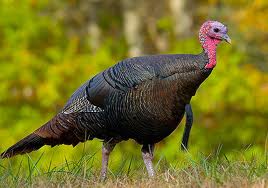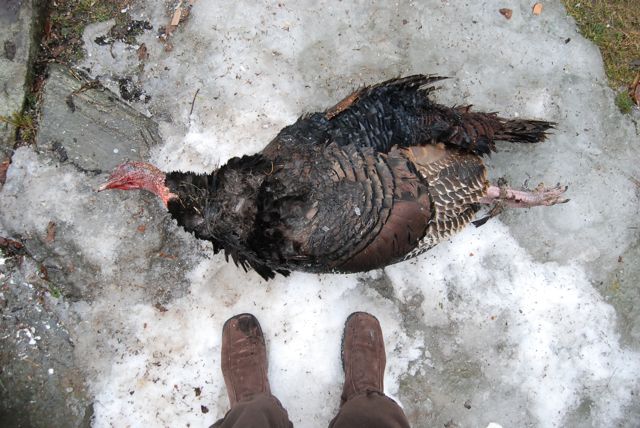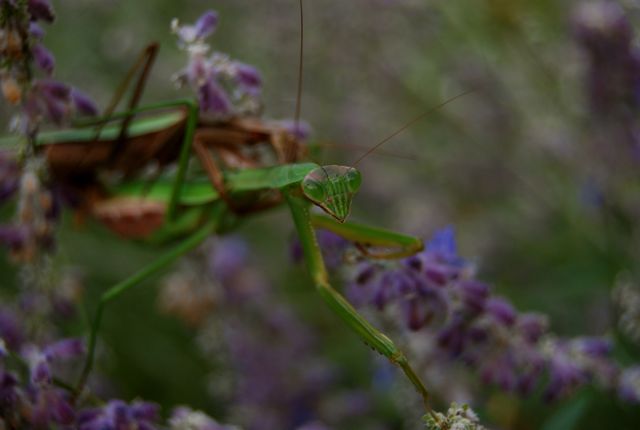You know how it feels when you’re falling in love? At first, it’s all hot and heavy and you can hardly think of anything but being with the other person. You live them, breathe them, you almost want to EAT them! But things eventually steady. The boil, though still burning, simmers down and you start to see stuff you hadn’t seen before. And often it’s these subtleties that’ll either END IT or enchant you all the more.
wildlife
A turkey named Wilbur.

A normal person who moved into a house where wild turkeys wandered the backyard might be inclined to ignore them until they went away. A normal person, once these turkeys disappeared, might describe the parting as fortunate. But since moving into our house, replete with flock of wild turkeys, my family and I have done our darnedest to bond with these big birds.
Turkey Floats

In yesterday’s post about the dead turkey, I mentioned the males are beginning to display. So I thought I would elaborate with some photos.
If you are from Philly, then you know who the Mummers are. If you are not, then you are missing out! The Mummers are a Philly tradition. They are a collective of local neighborhood clubs composed historically of men; nowadays there are lots of women too. These guys & gals get together over the course of each year to put together elaborate costumes and routines for an annual New Year’s Day parade. Some of the Mummers play instruments, others are strictly theatrical. But all of the costumes are over the top. Think MORE is MORE.
Here is an elaborately costumed Mummer.
And here is one of the male turkeys in full display.
Being from Philly, I can’t help but think of the Mummers. The male turkeys glide across the yard like mini parade floats. They strut, they cluck, it’s crazy. They want these lady turkeys SO BAD! But the girls, quite honestly, don’t seem to want anything to do with them. I saw one female (she must be one of the hottie turkeys b/c the males were surrounding her, strutting & bobbing like mad) she practically flew across the yard to get away from them. And seriously, can you blame her? Just look at those big red sacs – can you imagine some dude following you round Target w/ a dangly scrotum stuck to his face?! YIKES!
Turkey Surprise

Yesterday afternoon I had an appointment. When I left the house I noticed a bunch of turkeys in the backyard. Most of them were eating at the feeders, a few were standing around preening and/or dozing in the rain. A weird black mass lay several feet away from them, on the grass. It looked sort of like an empty trash bag. The day was gray and windy; perhaps something had blown out of the recycling bin? I was pressed for time, and the turkeys weren’t paying it any mind.. so I left. When I returned an hour later the turkeys were gone, but the *whatever it was* was still there. I squelched across the muddy yard to find..
A large male turkey sprawled stiff on the grass, surrounded by scattered feathers. He hadn’t been dead long. I wanted to touch him to see if he was still warm, but thought better of it. Frankly he looked a little scary. And I was in shock. I know these turkeys are wild creatures, but feeding them day after day, tossing them stale bread, addressing them as my “turkey friends” – well, they feel a lot more like family. I am so glad I hadn’t gotten round to naming any of the turkeys other than “Gimpy” (a small female w/ a bum leg). Makes it so much easier to say goodbye.
And so I did the only thing I could think of. I went and got a trash bag. NOT to dispose of the dead turkey – oh, no – but rather to move him to the ice drift by the back door of our house. As I said, he was a little scary (read, Bloody) and I was reluctant to simply pick him up and you know – touch him with my hands. I wrapped the bag around him like a blanket and cradled him in my arms. He was heavy and still. I felt the need to protect him. I don’t know why either – he was after all a dead turkey. But having him nearer to the house (without actually bringing him inside) felt right. It seemed like I was honoring his loss. He was some turkey’s son and I wanted to be respectful. I also wanted to ensure no other creatures would have their way with him before my husband got home and could check him out. The ice would help preserve him, and his proximity to the house would fend off intruders.
When my kids got home (along w/ one of my daughter’s best friends) I felt compelled to tell them what had happened and show them the body. They were grossed out and fascinated all at once. My husband, when he got home, was too. But all our dog wanted was to eat the poor beast, so we thought it best to dispose of him properly. So we did what anyone would do. We tossed him into the compost ravine. Well, more like “gently placed” him near the top of the compost ravine but slightly more in the yard so our neighborhood scavengers can use his body as food but we won’t have to watch it unless we want to. We are talking about a turkey here. Deliciousness itself. And since you’re surely wondering, Why Yes, my husband did at first suggest we eat him. Which struck me as equal parts savage and sensible, but altogether too messy for words. Having to pluck and clean this turkey out? No thanks. I myself considered dissection. I mentioned it to my older daughter, purely for scientific study. But we decided against that as well, more b/c of the mess than anything.
So, of course, the dead turkey reigned high on the list of last night’s topics of conversation. My husband suggested he was killed by a hawk. We do have several of them living in the woods behind us. But no savvy predator would kill and leave such a banquet behind. Besides, if it had been a hawk, the other turkeys would have been traumatized. Surely they would have FLED! not been stuffing their faces and napping. No, I knew this turkey had been killed by his comrade/s. Who had unleashed their fury, then turned to feast on the freebie buffet provided by yours truly..
Over the past few weeks, the males have begun warming up for spring. And by warming up I mean PUFFING UP. As in displaying. Like most testoterone ladden males of all species, the turkeys want the fairer sex to notice them. So they have been making themselves known by fluffing up their bodies, fanning their tail feathers (much like peacocks) and – well, to be honest, putting their manhood OUT THERE. Not their private parts, more like their public parts. Those sac things on their faces, those dangling gobblies, yep. Red as fire engines on some, swollen like (ahem) scrotums. This has been going on since the beginning of February. I actually noticed around the holidays the males faces looking redder & redder. Now it is even more pronounced. And like hormonal human males, some of them have taken this displaying even further. This weekend, John saw them fighting. Really going at it. But I’d never imagined they’d actually kill each other. SURPRISE!
Mantid Love.

We have a large butterfly bush in our front yard which attracts a huge variety of insects. Butterflies (of course), as well as all types of bees, flies, – this year we even had a hummingbird! Pretty darn rare in the city. Anyway. b/c of the number of butterflies, this bush is also home to a large cadre of praying mantises. Mantids LOVE butterflies. Their tender juicy middles in particular. After gobbling them up, they drop the butterflies’ colorful but otherwise unappealing wings to the floor below. So all summer long, while I’m weeding the garden, my daughters are gathering up the wings like so many discarded petals.
When I was a kid I never saw a praying mantis. But I clearly remember people saying they were endangered, and telling me never to kill one. I believe it was illegal at the time (the 1980s), but I haven’t been able to confirm or deny that. All I know for certain is that mantids are thriving in 2008 – at least in our yard. If a postage-sized stamp of a garden in the middle of a city is any indication of the greater picture, I’d say they’re doing fine.
And yet each time we find a praying mantis, you’d think it was the very first time. We drop everything. Holla to each other. COME QUICK! B/c we all want to see. Their thoughtful eyes and slender grace are fascinating. My daughters found a small one several weeks ago – of all places, beneath a checkout in Trader Joes. They scooped him up, and carried him out of the store. He seemed happy to be free. But rather than hop off outside the exit, he rode for blocks on my older daughter’s hand. Only once we reached the Market Street bridge did he fly off, soaring stories into the sky.
We’ve been fortunate enough to capture several others over the years. Not in any box, but on film. My skillful husband took these photos a couple weeks ago of a pair mating, and I just had to share them. They are beautiful. The text is excerpted from the North Forty News. Many thanks for sharing.
PS: We now have a large egg case on one of the branches. Here’s to next year’s offspring!
This brings us to the delicate subject of mantid love – or, more precisely, mantid sexual behavior.
Slender adult male mantids, smaller than the female, usually feature brown tones in contrast to the female’s greens. They display rather slow, deliberate care around prospective mates, often approaching from the rear and leaping on the female’s ample back when close enough. Females warrant this caution, even though their substantial weight keeps them grounded while males can fly, because a female may hunger for a substantial meal more than sex.
Sometimes she wants both.
Even attached and fully engaged, a male may literally lose his head servicing his chosen female. The female can swivel her head in a disconcertingly human-like gesture and decapitate her suitor. This may not even interrupt the act at hand. One author states that “removal of the male’s head, the bit which the female eats first, releases the male’s genitalia from nervous inhibition from the brain and leads to incessant copulatory movements.”
The smartest–or the luckiest–males avoid this circumstance, however, leap off their temporarily groggy paramour and run quickly away. Such mortal danger may insure that only the smartest males live to mate again.
Once inseminated, a female searches for a plant stem or fence post suitable for making an egg case and laying her eggs. Usually she selects a location 1 to 4 feet off the ground and constructs a case that resembles tan foam with the texture of a roasted marshmallow. Chinese mantids build round cases; the Europeans flatten theirs on one side.














